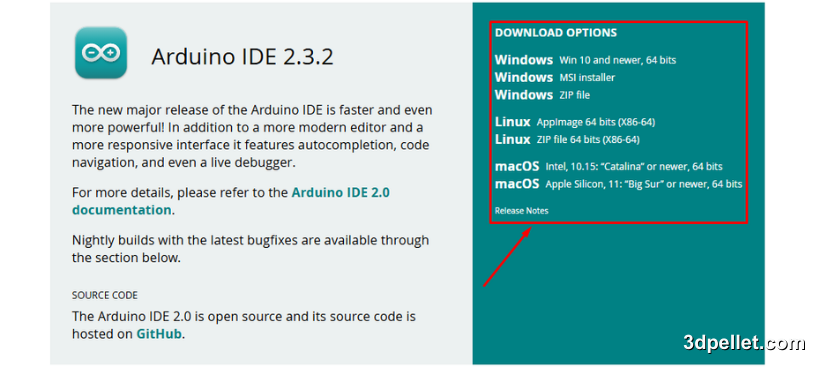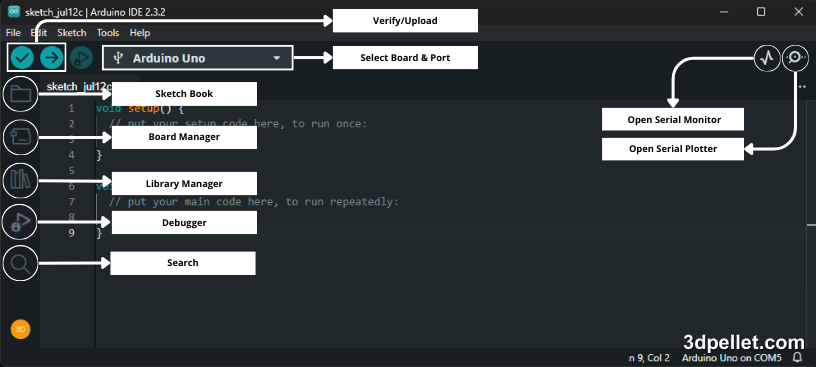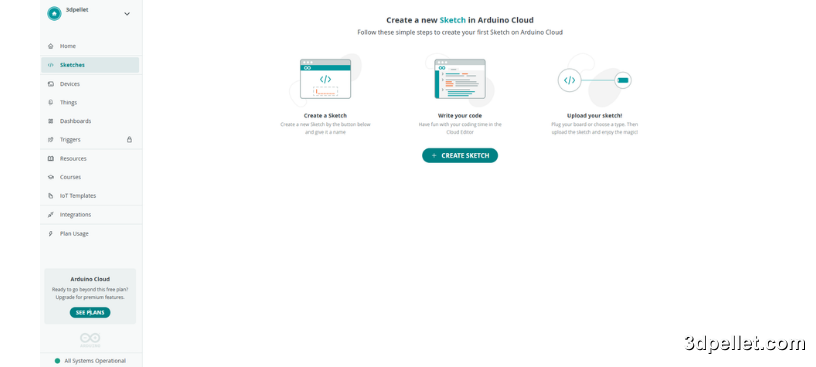Introduction to Arduino IDE

In the universe of electronics and microcontroller programming, Arduino has become an essential tool for beginners and experts alike. One of the key components to start developing projects with Arduino is the Arduino IDE (Integrated Development Environment).
What is Arduino IDE?
Arduino IDE is software that provides a C/C++ based development environment for writing, uploading, and running code on Arduino boards and other compatible boards. It is a free, open-source application that greatly simplifies the programming process, allowing users to focus on the logic of their projects without worrying about setting up compilers or complex debugging tools.
Currently, it is in version 2, which is an improvement over the classic IDE, offering better performance, an enhanced user interface, and many new features. Among these new features are autocomplete, a built-in debugger, and sketch synchronization with Arduino Cloud.
Installing the IDE
To start writing code for an Arduino project, you first need to download and install the Arduino IDE from its official website . If you are using a Windows operating system, download the appropriate installer and install it on your computer in the usual way. If you do not have permissions to install programs, you can opt for the ZIP file for Windows. Simply extract all the files and open the software by clicking on arduino.exe within the extracted folder.
For Linux users, downloadable files are available for 32-bit, 64-bit, or ARM systems. macOS users can download and install the specific version for Mac OS X.

Overview
After installing the IDE, we can open it and start using it. Version 2 of the IDE features a new sidebar that makes the most commonly used tools more accessible. Additionally, there is a menu bar located at the top, which includes the File, Edit, Sketch, Tools, and Help menus. Through these menus, you can access a variety of commands and options to manage Arduino projects. At the bottom of the window, there is also a status bar that allows the user to quickly see any error or warning messages. Finally, the code editor occupies the largest area of the window. This is where programs are written and later uploaded to the microcontroller being programmed.

Features
The Arduino IDE 2 is a multifunctional editor with numerous features. It allows for direct installation of libraries, synchronization of your projects with Arduino Cloud, code debugging, and much more.

Sketch book
The Sketch book is a specific folder on your computer intended to store and organize Arduino programs. When you install the Arduino IDE, a default folder is created where sketches are saved by default. However, you have the option to choose a different location to store them if you prefer. This is especially useful for keeping sketches organized, making backups, or sharing them with others. This feature also offers the possibility to store sketches online by connecting the IDE to an Arduino Cloud account.
Board Manager
The Board Manager allows you to search for and install specific board packages. A board package includes the necessary instructions to compile code for the boards compatible with that package. For example, the Arduino AVR Boards package, which comes pre-installed, includes support for Arduino Uno, Arduino Mini, and Arduino Ethernet, among others.
Library Manager
The Library Manager allows you to install libraries created by both Arduino and third parties. These libraries are extensions of the Arduino API and simplify tasks such as controlling a servo motor, reading specific sensors, or using a Wi-Fi module, among others.
Debugger
The debugging tool is used to test and debug programs, as its name suggests. It allows you to navigate through the execution of a program in a controlled manner. Whether you are experienced or new to programming, this tool will be extremely useful for finding errors in your code, reducing mistakes and headaches in the design process.
Search
The search function allows you to find specific text within your code. This shortcut is very useful and is commonly found in any development environment.
Serial Monitor
The Serial Monitor is a tool that allows you to visualize data transmission from your board, for example, using the Serial.print() command. It is widely used to test both hardware and software during the development stage.
Serial Plotter
The Serial Plotter tool is ideal for visualizing data through graphs, allowing you to monitor multiple variables simultaneously. It can be used to test and calibrate sensors, compare values, and similar tasks.
Example Sketches
A fundamental part of the Arduino documentation is the included examples. These examples show how to use functions in practice, illustrating the intended use and features of a library.
To open the examples, go to the File > Examples menu and search for the desired library in the list that appears.
Arduino IDE in the Cloud
As an alternative to the traditional IDE, Arduino has evolved and ventured into cloud services. The new Arduino Cloud Editor allows you to start projects without dealing with annoying configurations or maintenance headaches. Additionally, being a web-based tool, it can be used with any device that has a web browser. Other advantages include new tools such as the machine learning toolset and the ability to link a physical device to the cloud. It is not an expensive service for individual use and even has a free plan that includes 100 MB of storage, machine learning tools, and two devices connected to the cloud.

Why Use Arduino IDE?
- Accessibility: It is easy to learn for beginners and powerful enough for advanced developers.
- Abundant Documentation: There is a large amount of documentation, tutorials, and examples available online, making learning and troubleshooting easier.
- Flexibility: It allows programming a wide variety of projects, from simple blinking lights to complex automated systems.
Conclusion
Arduino IDE is not just a development tool but a complete ecosystem that fosters creativity and innovation in the field of electronics and microcontroller programming. With its intuitive interface and powerful set of features, Arduino IDE is the ideal gateway for those who wish to explore the exciting world of Arduino and beyond.